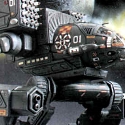|
Siegkrow posted:The SA forums are getting brought back in the new planet. Humanity repeats the Great Mistake 
|
|
|
|

|
| # ? Jun 1, 2024 20:41 |
|
Who are we most likely to butt heads with? And if Firaxite's a problem, what about Xenomass, since I assume we need that for Harmony units?
|
|
|
|
SSNeoman posted:Who are we most likely to butt heads with? And if Firaxite's a problem, what about Xenomass, since I assume we need that for Harmony units? Having recorded the next update... if we go to war with anyone - which I don't think is likely until we start a victory path - I think it will be the North Sea Alliance. They're going Purity, and we're still politely neutral with them. One of the two remaining neighbors who we'll meet in the next update has already gone for a cooperation treaty with us, and the other is currently at war with INTEGR, who we're neutral with. Xenomass is not a problem, at all. We've got loads of the stuff, and in the next update we'll get more. Tech-wise, the next update is finishing out the important early game techs and picking up a couple more things that I think will be useful, but I may open a thread vote for our tech direction at the end of the update. There's a lot of useful stuff we could get, and will, it's just a question of what I go after first. Odds are, I'll be asking the thread to vote on whether they want affinity-specific units and buildings now, to prioritize techs we need for standing quests, go for raw improvements to the colony's functioning, or simply go for what I think is fluffy for this LP. As a look ahead, Arshia Kishk will be trading up to her first Supremacy outfit:  Arshia's outfit changes are subtle compared to most, she never loses the jumpsuit-like look she starts with (and those of you who know the game can see from this who our remaining two neighbors are). Cythereal fucked around with this message at 18:55 on Aug 24, 2019 |
|
|
|
I think we have a few sources of xenomass, don't we?
|
|
|
|
I say upgrade your basic units at least, having a strong standing army is a good defense before you start climbing that tech tower.
|
|
|
|
Siegkrow posted:I say upgrade your basic units at least, having a strong standing army is a good defense before you start climbing that tech tower. I have. Our first Supremacy-specific upgrades will appear in the next update. Like I said, I'll probably make that part of the next update with a more detailed explanation of what that means.
|
|
|
|
So, since we are going Supremacy/Harmony, will we be getting our own E.V.A units later on (emotionally unstable teen pilots optional)?
|
|
|
|
Sylphosaurus posted:So, since we are going Supremacy/Harmony, will we be getting our own E.V.A units later on (emotionally unstable teen pilots optional)? Ha ha, not a chance. This isn't a dystopia and teenagers are in school, not the military. Recursion State of Al Falah, Turn 113  Ard  Farah  Aswat Adida  Midfa'a  This is one of the weirder results of explorer expeditions: a bunch of points in a randomly chosen affinity. If you ask me, this should have been patched out or replaced with the pick-an-affinity result.  Still, note the hybrid bonuses. We don't give a drat about Purity, but we'll get these bonuses all the same.  While the Civil Administration largely dismissed the results of the expedition, the explorers were proud of the trophy they came away with.  The First Squadron of Al Falah's navy looked on in alarm as the check for the Alliance's campaign of extermination came due. The kraken outmassed the Alliance gunboat three times over.  The NSAS Vanguard went down with all hands. Search and rescue craft from Al Falah found nothing but an oil slick and floating debris. This is why I don't pick fights with the aliens fyi.  The Al Falah Defense Force finally created a separate Orbital Operations division, reflecting the close integration of the Al Falah military with space-based technology.   The first confirmed sighting of a siege worm by Al Falah prompted a communique from a bitter Alliance military officer. So, siege worms. Krakens are their aquatic counterpart. Remember this art I posted on the first page?  That's a siege worm. And it's even on an arctic world with Supremacy/Harmony infantry in the foreground!  I couldn't get a good shot of it last time, but now you can see the Faraday Gyre near Farah. Like Civ5, wonders you build will appear near the city.   The first major debate in Orbital Operations ended with a victory for expanding Al Falah's orbital coverage. The further our coverage reaches, the further our Integrated trait will work. The alternative gives a bonus to satellite production.  Al Falah's scientists were nowhere near unlocking Al-Jalidia's secrets. But they had taken another notable step towards that goal. Xenomass had been observed by Al Falah since shortly after Planetfall, and Al Falah had finally learned how to harness this resource. We can finally improve and use xenomass! We have a lot of the stuff, which is good because both of these buildings require a city with access to it. Xenofuel plants produce energy, and xenonurseries produce science. Xenomass itself as a resource produces a lot of food.  The next research project was something closer to home: large-scale environmental alteration. No one in Al Falah had any particular goal of actually terraforming Al-Jalidia, but learning to tame this harsh world promised all manner of interesting discoveries along the way. The building here is no good for us and probably won't ever be, but Terraforming lets us make use of floatstone, our last alien strategic resource, and build terrascapes. Terrascapes are very handy and I'll probably make at least a few.  Kishk's emergency briefing about Kavitha Thakur was frustratingly vague. Even on Earth, separating fact from fiction about the woman had been difficult. What was known for certain was that she was the daughter of Raj Thakur, the charismatic demagogue and religious prophet who had reunited the Indian subcontinent after the Mistake, and that she was fiercely dedicated to the Seeding. She was charismatic in the extreme, and followed by the Indian people with loyalty bordering on outright fanaticism as a religious figure as much as a secular leader. Beyond that, details about the leader of the Indian Protectorate were elusive. Her followers attributed all manner of miraculous feats to her: she was centuries old and born in the twentieth century, she communed with the gods every day, her mother was a deva or angel of some kind, she could see the future, and countless more stories. The woman on Kishk's viewscreen looked no older than her mid thirties, scarcely older than Kishk herself, and spoke flawless Earth Arabic without a trace of an accent. Kavitha is a pretty middle-of-the-road leader in most respects as an AI leader, sitting square in the middle of the pack for almost every behavior parameter. The one really exceptional thing about her is her loyalty rating, which is the highest in the game. If Kavitha likes you, you've got a friend for life. She also has a very potent sponsor bonus, without being as downright broken as Daoming's over in the PAC.  Kishk assumed this was a compliment.  By this point, derelict human settlements barely made the morning news in Al Falah.  Kishk pondered her latest email from Thakur. Was the woman talking about the desertification and dust bowls that had destroyed the American Great Plains? The beaches expanding inward as sea levels rose and remade coastlines? Or was she speaking of a metaphorical kind of sand? I'll let you in on a secret: I made sure in advanced options that Kavitha would be here just because I love how weird her tweets can be and wanted to share them with the thread.  Midfa'a grew from tiny frontier outpost to Al Falah's latest city with lightning speed. The Greek refugees in particular flocked to Midfa'a, making a strong imprint on the city's culture.  Large-scale investment from Ard quickly followed. Like in Civ5, you can buy buildings with money - or, as you can see here, with diplomatic capital. We have shitloads of money we're not doing much with, though, and I do have priorities for diplomatic capital, so I just buy an autoplant and recycler. Rising Tide made it so you can't buy trade depots, and I really want that trade route with New Babylon before the station folds and the quest fails.  With no urgent tasks for the city council, Ard turned its factories instead to building better housing for the city's residents, expanding school facilities, building public parks, and similar activities. There's nothing I want to build in Ard right now and I'm satisfied with the current size of our military, so I set Ard to converting its industry to culture. Al Falah is better at this than anyone thanks to their sponsor bonus, and with Ard's immense production output at this point in the game, we're getting a hefty chunk of extra culture every turn. The 2 above the city name indicates that I have two squadrons of aircraft stationed in the city.   Limit the use of automated workers? Far from it, the Office of Labor encouraged the further expansion of automated labor. This used to be hands down the most broken quest in the entire game. +2 energy, or an extra trade route.  The Asabiyyah Party won several victories in this year's elections, promoting a more standoffish attitude towards other colonies and a stronger emphasis on self-reliance. Previously just a nuisance to the Externalist Party, the Asabiyyah shifted their rhetoric and policies to court the Sleeper refugees and their descendants. By this point in time, only the most fringe conservative parties in Al Falah's legislature still preached anti-refugee sentiments.  The Asabiyyah meant it, too. A considerable increase in government investment in public healthcare, education, and infrastructure followed.  Daoming Sochua was only the latest colonial leader on Al-Jalidia to marvel at Al Falah's booming industry.  Midfa'a wasted no time fulfilling the Assembly's mandate to seek new trading partners, while the Hermes Industries refugees revealed their contribution to Al Falah's memory of Earth: a holographic recreation of the Parthenon on Earth. Most of the Parthenon had been destroyed in the horrific Hurricane Alaric, the first Category 5 hurricane to penetrate the Mediterranean and a storm that inflicted terrible damage throughout the Mediterranean basin. But Hermes Industries had somehow obtained one intact pillar of the Parthenon and brought it with them to Al-Jalidia. Now that pillar was part of Midfa'a's central park and museum. Sorry if there are any Greek goons reading this!   Hey, doesn't this look familiar?  New Babylon was amused to learn that Al Falah was already thoroughly acquainted with these drones, as a matter of fact. What these events changed was not access to the drones in the first place, but their affordability. The drone control centers widespread in Al Falah were expensive and elaborate affairs that required highly trained personnel. This new generation of drone technology made industrial drones practical for even motivated private citizens to obtain and use. What was already a common feature of the airways in Al Falah cities soon became downright ubiquitous.  Chungsu officers assigned to Al Falah found the quiet revolution disturbing. To the people of Al Falah, increasingly sophisticated robots becoming a part of everyday life was exciting. What really took off in Al Falah was the development of so-called 'intelliwear,' body suits with integrated on board computers. Intelliwear suits could trigger automated cooling or heating systems in response to external temperatures, the wearer's body temperature, and the wearer's own preferences. They could automatically fold out eye protection when overly bright light was detected, and continually alter the shoes' tread based on the surface the wearer walked on. Muses now whispered directly in the ear and could read even subvocal commands.  Secretary-General Arshia Kishk was not known for her fashion sense, but even she started wearing an intelliwear suit most days. Level 6 in an affinity is when a leader's appearance first changes, though Arshia will always stick to a jumpsuit-like outfit and so her affinity changes are more subtle than most. Please ignore this screenshot being a bit out of sequence, I forgot that this was when appearances changed until later in recording.  And it's time for unit upgrades, including our first affinity-specific ones!  The growing technological prowess of Al Falah meant that piloted aircraft finally replaced the early tacjet drones. At least for now... Yes, it's a SMAC reference. Supremacy airplanes are designed to utterly destroy other aircraft, so I take the anti-land bonus here to provide some flexibility.  For the Defense Force, powered exoskeletons finally became a reality, letting soldiers wear armor and carry equipment that would have been too burdensome for conventional soldiers to bear. But what made the so-called Disciples really special was their combat-assist intelligence. Not quite a fully fledged AI, every soldier's suit was networked to every other soldier's, and every soldier's CAI constantly communicated with every other, sharing battlefield information at the speed of light and projecting the data and intelligence of the whole unit to the soldier's HUD. Combat exoskeletons and portable masers made Disciple units merely more dangerous than conventional infantry forces. It was the CAI made them far more than merely well trained, superbly equipped soldiers. CAI made them heroes. This is very typical of Supremacy upgrade choices, and I take the flat 20% bonus. It's less efficient if the unit is adjacent to three or more units, but only requires one adjacent unit to provide a bigger effect.  CAI technology was also incorporated in the new Tenet class frigates to similar result. Perhaps even more important for Al Falah's navy, however, was the capability - and sheer scope - of automation now possible. A typical Zonchio class frigate, previously the mainstay of the Naval Defense Force's lighter squadrons, had a crew of around 120. A Tenet carried a crew of twenty. The flanking bonus is certainly good, but I prefer the universally relevant adjacency bonus.  INTEGR observed Al Falah's latest industrial revolution with some pessimism.  To say the latest refugees, formerly a North Sea Alliance corporation with more ambition than sense, were overwhelmed by Ard was an understatement. The predominately Welsh company workers had anticipated linguistic difficulties. They were met by almost everyone having an automatic translator at hand. Albeit not the most efficient kind, even Al Falah's latest translation software struggled with Welsh at times.  Explorers reported a curious sight: raptor bugs broadcasting PAC IFF codes. Closer inspection revealed radio collars around their necks, suggesting at least some degree of docility. Turns out we weren't the only ones who went exploring and got some tame bugs.   The Xenoharmonists, a small but influential political party generally part of the Asabiyyah Party's coalition, were disappointed when the Civil Administration decided to increase harvesting of xenomass resources. It's not really a choice. Xenomass wells give a big food bonus. Now they also give a fair chunk of energy and production. The alternative is a one-time reward of energy for the coffers (batteries?).  Even Kavitha Thakur complimented Al Falah's titanic industry, in her own inimitable way. Seriously, I think Duncan is the only leader who hasn't gone Industrialist.  Actually making any effort to terraform Al-Jalidia had few supporters in the Assembly, but smaller-scale alterations were believed to be possible and useful. Gaian wells require a certain amount of Purity and produce energy. Floatstone is our last alien resource to unlock, and terrascapes are a very powerful tile improvement for tundra and snow. Like we've got loads of around Ard.  Another incidental level of Purity.  The studies did, however, provoke a wave of scientific interest in better cataloging and observing the native organisms. With our Supremacy level already at 6, Harmony's lagging behind. Y'all voted for us going S-H, so I pick up the fastest Harmony tech on the board. It's a handy one to boot.   Xenoharmonists rejoiced when scientists successfully grew xenomass under laboratory conditions. Xenomass, it appeared, was a renewable resource. The alternative is a one-time boost of science. I opt for more xenomass instead, even though we're not likely to run out.  Again!   Farah had remained roughly stationary throughout the city's existence, and moving the ARK was deemed highly unlikely in the future by the city council. The scientific boon of the thermohaline rudder was therefore judged the more important aspect of the facility's operations. +1 science or a bigger bonus towards moving the city. I don't tend to move my sea cities much, but some people do get a lot of mileage out of it.  A detailed survey of Al-Jalidia's wildlife did not take long. The Vanishers had long since been domesticated by Al Falah, and other species might well follow. The alien preserve is a culture building that requires level 2 Harmony to build - which we can. Explorers can also now leash most aliens, sacrificing a big chunk of their HP to permanently tame an alien unit and bring it under your control. I don't tend to remember having this available, but now that I'm writing this update I'll try to make use of it in the next update.  The Xenoharmonist Party grew in the wake of the latest discoveries. Technophiliac though the Al Falah had become, a deep interest in the natural world also began to take hold in popular culture. In Aswat Adida and Mortifa'a, ecotourism began to take off in the patches of forest and native landscape that had escaped the city's growing infrastructures. Set to maximum warmth, most brands of intelliwear suits could keep an unprotected human alive indefinitely in the relatively temperate latitudes of Al-Jalidia. At least during the day. We skipped level 3! Level 3 Harmony posted:If you can, touch a Siege Worm as it moves by. That will teach you all you need to know about the insignificance of humanity.  Kishk paid those developments no mind, her attention lay with the new face on her video screen. 'Kubwa Mjomba' - 'Great Uncle' - indeed, Samatar Jama Barre had been more formally titled Prime Minister of the Peoples' African Union on Earth. And before that, Major of the Peoples' African Liberation Army. More than one world leader on Earth had understimated this man to their great regret, Kishk's newlywed wife had warned her. Underneath that jovial, pleasant facade lay a dangerously intelligent mind, a keen awareness of how much his people had suffered and been exploited throughout history, and a willingness to do whatever it took to prevent that history from repeating itself. The fact that Barre and Lena Ebner of INTEGR were at war on Al-Jalidia when they had been close friends on Earth testified to that. Barre had been a friend of Al Falah on Earth, too, and that old bond was no more likely to hold sway over the man now. The Peoples' African Union had had more Seeding starships in construction than any other Earth power at the time of the first wave's departure, and every single one of them was determined to write a future for their people that would be very different from the past. As noted, don't be fooled by how friendly Barre is. He really is very friendly and loves to trade and be friends, but he's also a very wary customer who will not hesitate to strike first if he thinks you're a threat and he doesn't care how friendly you've been up to that point.  The next priority for Al Falah's scientists: intelligent computer systems that didn't need human input at all to work. I know what I just said about affinity levels, but I really want the wonder here.  Explorers sight a derelict settlement just outside the African Union city of Ayaan. After a brief exchange on the radio, the Union gives Al Falah permission to investigate.  Number three this update.  Work begins on a closed-habitat replica of an idealized Earth environment outside Ard. Mostly, the Civil Administration admits, just to see if it can be done on Al-Jalidia.  Kishk declines to comment in the absence of knowing who started the war between INTEGR and the Union.  Put to a popular vote, the Civic Duty Act passes with a substantial majority. Henceforth, a period of one year of service for the Al Falah government - be it military or civil in nature as the citizen decides - will be required upon graduation from basic education.  African Union dignitaries are stunned to see the Faraday Gyre in action at Farah. If energy is the currency of the future, then Al Falah is a wealthy colony indeed.  The museums and thriving cultural scene of Ard are just as impressive to the diplomats in their own way.   The Offices of Labor and Health were in complete agreement: the operation of Farah's tidal turbines should not come at the expense of even the poorest citizens of the city. I'd pick this option no matter what the result was. The other choice is +2 energy, you monster.  Survivors from the Tlaloc Initiative's disastrous crash were located by explorers and brought to Ard even as the African Union's embassy was under construction. The Spanish-speaking Initiative colonists, whose organization had been based in Mexico, do not last long in the city's online news cycle. The Civil Administration are old hands at resettling Jalidian refugees at this point. From the sea settlement we saw earlier, not the town outside the African Union.  Some might have worried about overcrowding in Ard, but truth be told the Magnasanti Effect was widespread throughout Al Falah. Perhaps going back to the shipboard conditions of the original Al Falah colonists and the cramped quarters characteristic of the semi-abandoned settlements of the many refugee groups that had come to Ard, a certain strain of agoraphobia was widespread among the modern population. Even when offered a choice of living spaces, the Al Falah increasingly began to prefer smaller, more closely packed spaces to live and work. Not only were such arrangements more efficient when open space was minimized, Ard did not threaten to sprawl as massively as Earth's great cities had. The foreign officials of Embassy Row may have disagreed about much, but there was one thing they all agreed on: the people of Al Falah were strange, and getting stranger.   The Chang'e Scholarship Program, named after the first permanent Lunar colony - the PAC's - from Sol, was very prestigious as soon as it was instituted. Students of academic excellence and pioneering spirit in both Al Falah and the Pan-Asian Cooperative benefited. It's not a lot, but it saves us some food and I'd like to keep the PAC happy with us. Daoming's Supremacy score is now just as high as her Purity, perhaps she's seen the light? Also, student aid just feels like a nice guy thing for us to do.    A direct interface between a living brain and a computer? The idea wasn't new, but someone seriously proposing it was another matter. Debate concerning the ethics of the experiment in the Assembly was surprisingly short-lived. Shorter than Arshia Kishk expected, if she was to be honest. Ethical questions regarding the proposed mind/machine interface were focused on how to implement the interface, not whether or not to implement one... Wait, what? So yeah, we've seen both this and the drone before. This quest line checks that you don't have the drone or helmet in your artifact inventory as a condition in order for the quest to happen, but the game doesn't record whether you've previously had them and expended them.  Another one bites the dust.   The brief history of diplomatic relations between Al Falah and the Protectorate had been polite but non-committal. The colonies were simply too spread apart on Al-Jalidia to have any strategic concerns with one another, and the to date rather conservative Indians seemed to have little in common with the technophiliac Al Falah. Kavitha's sudden decision to pursue closer relations came as a surprise to both nations, and the treaty was signed a few weeks later. Not sure what prompted this, but I'm not complaining.  Powerful and omnipresent as smart systems, computers, and robots had become in Al Falah, there had always been a human in control. Such machines required trained operators, and close supervision. Until now. The drone cage is our first affinity-specific unit! It's actually Supremacy-Purity, but we can make them too (though we won't, since they require firaxite). The Node is a Supremacy specific tile improvement that does nothing interesting for us, I may build one just to show them. What I'm here for is the wonder: Master Control grants all our workers +1 movement. If you aren't a Civ fan, you might be wondering what the big deal is. If you are a Civ fan, please keep your salivating under control.  In any previous society, this would have been an ominous development, a troubling sign of an uncertain future. To Al Falah, it was only a natural development that made an important part of everyday life even better. Increasingly, the omnipresent drones and robots found throughout Al Falah's cities no longer had human operators at all.  The idea was put to the Office of Science and Development by a Xenoharmonist spokesman: Al Falah's machines and technology had adapted well to the brutal challenges of Al-Jalidia. Why should Al Falah not adapt biology to meet those same challenges? Doing this mostly for more Harmony points, and there's a useful colony perk. If I hadn't gotten Slumber-Slaughter Extract, I'd be going for a different tech instead.  It's that time again!  Next-generation CAIs were only one part of the Arbiter class's radical improvements over the Corsair class of old. The Arbiter was fast, durable, armed to the teeth, and carried a crew of forty-five. The defense bonus is interesting, pure defensive bonuses are normally a Purity thing, but if we get into a war I'll be using these ships offensively as well.  The so-called Overseer battalions benefited from the same technology as the Disciples.  And the premise was simple: once a sufficiently effective and flexible pattern is established, scaling that pattern up or down is significantly easier than making new designs from scratch. Another major victory for the Asabiyyah Party in the Assembly involved a ground-up overhaul of Al Falah's industrial infrastructure as a key plank in the platform. State of Al Falah, turn 147 By this point in time, adherents to Earth calendars were rare in Al Falah. The Planetborn - so many of them possessed of that curious mirror-touch synesthesia - were reaching adulthood, the first generation of Al Falah to have never known life on a starship. They were a hardworking people, the Al Falah, industrious and innovative. They were not the people they had been when they had arrived on Al-Jalidia, and an INTEGR diplomat at their embassy in Ard spoke often of the curious energy that characterized life in Al Falah's largest city. There had always been a sense of purpose to the people of Al Falah, a sense of motion and direction. Where they were going now, the diplomat reported to her superiors in Weltgeist, remained to be seen.  Ard remains the largest city in Al Falah, and is almost certainly the largest human settlement anywhere on Al-Jalidia. The so-called terrascapes take shape to the west of the city, and Al Falah's new Arbiter class cruisers patrol the waters near the city en masse. On the edge of the city, a massive new complex is taking shape: what will be home to the Advanced Resource Allocation and Development System, the largest and most sophisticated computer yet devised by humankind. To the people of Ard, however, the ARADS has another name. Master Control.  Farah continues to grow, and the city's infrastructure has recently been interrupted by a kraken. The leviathan crushed a coral harvesting station without ever noticing the station's existence - fortunately without casualties thanks to Al Falah automation. The Al Falah navy is currently moving to intercept and corral the beast before it can inflict further damage.  Once the wild frontier of Al Falah, Aswat Adida has by this time become a settled city. The wilds are still not fully tamed, but pioneer units are working on that.  Midfa'a is growing fast and retains the city's characteristic Greek imprint on the local culture. The cuisine wars between Midfa'a and Aswat Adida are already becoming a thing of legend. And now, a vote! There's a lot of stuff I can research now, all of it useful. This research falls into a few broad areas, though, so please vote for what you'd like me to focus on for the next update. Option 1: Unlock new units and structures. We're a fair bit into the affinity system now, and don't have much unique to show for it - the alien preserves I've built off-screen and the drone cages I don't have the resources for. I could dedicate my research to getting us more stuff to play with (at least in theory). Option 2: Finish our quests. We have two standing quests asking for techs we don't have yet, one Supremacy and one Harmony. Fixing that wouldn't be hard. Option 3: Core colony improvements. There's a variety of techs we could research to improve the core functioning of the colony in various ways without actually adding a whole lot of new stuff. Option 4: Do what's fluffy. Al Falah's direction in the story is heading in some interesting directions, and I could certainly think of techs it would make sense to have appearing at this point. Vote for this if you want what I think would be logical for Al Falah in a story sense to pursue.
|
|
|
|
I'll toss in a vote for #2: Finish Our Quests because more affinity levels = better than
|
|
|
|
I'm greatly enjoying the story you're managing to wring out of beyond earth, so Option 4 feels the most appropriate. That said, if you come up with a fluffy way to finish up a quest or two, that'd be nice as well. After all, what is biology if nothing but organic tech? A quest-required harmony tech wouldn't be out of place.
|
|
|
|
Go with the fluff. For all the warnings at the start of the thread about Beyond Earth not having a strong story, the Let's Play has certainly got me invested in how Al Falah's society develops. I wonder, assuming this is purely a narrative thing, do the other nations have their own names for Al-Jalidia? Or was Al Falah's early cultural presence (and apparently being the first to arrive) strong enough that everyone has adopted the name?
|
|
|
|
Tenebrais posted:I wonder, assuming this is purely a narrative thing, do the other nations have their own names for Al-Jalidia? Or was Al Falah's early cultural presence (and apparently being the first to arrive) strong enough that everyone has adopted the name? 'Earth' isn't what our planet is called in Arabic. The Arabic name for our world is in fact 'Al-Ard.' It's certainly Al Falah's name for the planet, and given that Al Falah was both the first successful colony on the planet and seems to be the most powerful of the lot right now, their name for the world probably carries a lot of weight should the colonies ever put together a space UN or something (no such mechanic exists in Beyond Earth). Any of our victory paths will probably lend further authority to Al Falah's version of things becoming the 'official' terms. Based on the city names of the various sponsors, we can put together a reasonable guess of the official language spoken in each colony: Al Falah: Arabic Chungsu: Korean NSA: English (note: the NSA is one of the most linguistically diverse sponsors in Beyond Earth - Swedish or Scots Gaelic or some creole between those and English would be equally likely!) PAC: Mandarin Chinese (possibly a creole with Vietnamese) INTEGR: German Kavithan Protectorate: Sanskrit (possibly a creole with Urdu) African Union: Swahili (another very diverse sponsor, possibly a creole with Somali, Xhosa, and/or Zulu)
|
|
|
|
Option 4
|
|
|
|
I've really been loving the fluff you've made so far, so I'll say Option 4.
|
|
|
|
The correct answer is always Fluff!
|
|
|
|
Fluffiest fluff that ever fluffed.
|
|
|
|
Definitely 4, however we get to our purple robot suits, it's got to be fluffy.
|
|
|
|
We should clear out that Quest log for now
|
|
|
|
Quests first, then fluff.
|
|
|
|
2->4
|
|
|
|
2-> though I like the fluff. I kinda wanna see the weird stuff we can unlock as well. How long is a typical game cause we're 150 turns in and just hit our first branching upgrades?
|
|
|
|
SSNeoman posted:How long is a typical game cause we're 150 turns in and just hit our first branching upgrades? I'd say we're approaching the halfway mark. Beyond Earth is fairly slow paced, and the affinity level requirements for the various affinity-specific victories are level 15. The tier 4 upgrades for our basic soldiers and patrol boats come at level 11 if going mono-affinity, or 6 of each if you're going hybrid - we could very well see tier 4 units in the next update. The mechanical tradeoff for getting hybrid units earlier is that they each inherit only one upgrade perk option from each of their respective affinities - almost invariably what the game considers the weaker option. We're going S/H, so our tier 4 infantry will pick between +30% strength when flanking or all terrain costing only 1 movement point (like explorers). If we were going straight Supremacy they'd pick between the flanking bonus or passively healing all adjacent friendly units for 10 HP a turn. If we were going straight Harmony, they'd choose between the movement bonus or gaining 30% strength when in miasma. Both disciples (the Supremacy t3 infantry) and brawlers (Harmony t3 infantry) can upgrade into Hellions (S/H t4 infantry) and bring the upgrade you got for the disciple or brawler with them. S/H's unique units are weird - they include two of the game's three stealth units, the third being submarines. Only the Aquilon (the cyborg flying whale aircraft carrier battleship) costs firaxite, so we'll definitely see geliopods and nanohives. I will not be shooting for a victory as soon as I hit 15 in an affinity, though. For thoroughness' sake, I am going to take our primary affinity to 18 before the game's end, and there's a couple not-strictly-necessary things I want to grab for the LP from deep in the tech web. Why yes, the Human Hive is in fact a Supremacy wonder and I intend to build it.  Oh, and have more civlopedia. Kavithan Protectorate posted:With end of the Great Mistake and the devastation it had brought, the Indian subcontinent's economic and political position was more precarious than ever. Populations faced extensive coastal flooding, crop failure, and pandemics with limited international humanitarian aid. Millions of refugees poured across India and surrounding nations in the greatest human migration on the subcontinent since the partition in 1947. Clashes between political and religious factions among desperate groups increased, and the centralized political power had only limited ability to help. The specter of a balkanized, ethnically torn subcontinent seemed all too likely. Kavitha Thakur posted:Although western scholars are almost uniformly incredulous, the followers of Kavitha Thakur hold fast to the claim that she was born on the first day of June, 17 years before the events of the Great Mistake, making her well over 200 years old. More reliable estimates concede she may be considerably older than the average life expectancy. Peoples' African Union posted:Although untouched by the consequences of the Great Mistake, the African continent suffered from the migration of those fleeing their homes. As the seas rose, more refugees retreated from North Africa and coastal African nations. The humanitarian disaster shattered the fragile economies of many of the African nations, and destabilized regimes across the region. A generation-long cycle of coups and short-lived dictatorships, as well as an epidemic of border wars, tore Africa apart. While much of North Africa would eventually join the Franco-Iberian European Union, alleviating some of the pressure, the sub-Saharan nations struggled to return to order. Samatar Jama Barre posted:Avuncular, genial, affable, affecting an air of bonhomie, Samatar Jama Barre wished to be addressed as Kubwa Mjomba (“great uncle” in Swahili) by those he both commanded and protected. Despite his seeming benevolence and absent-minded demeanor, he was nonetheless an efficient and effective administrator, an able diplomat, and ruthless when necessary. Barre was amused and likely pleased when detractors likened him to the traditional African village chieftains of the past, claiming him to be a throwback and out-of-step with the new world in the wake of the Great Mistake. But the Peoples’ African Union made a wise choice when he was selected as one of their colony governors. Computing posted:By the end of the 20th Century, computers had become an essential element of life on Old Earth. In factories, offices and homes, computers dominated human existence. When the colonists landed on this planet, it was vital for them to advance and adapt computing to survive. Discoveries in unique materials and advances in networking allowed ever more tasks to be transferred to the oversight of advanced computers. These advances would eventually lead to advances in cybernetics, as quantum computers were made ever more compact, and given sophisticated programs that approached self-awareness and creative intelligence. Within a few decades of arrival, the distinction between human and artificial intelligence had blurred to the infinitesimal. Network posted:As soon as feasible, colonial administrations established computer networks similar to those on Old Earth at the time of the Seeding. Since the ancient days of ARPANET, modern life has been driven by the data-interface exchange of the many types of networked computers; without this ability research, education, medicine, all human activities would revert to the Information Dark Ages of the early 20th Century. Although small compared to the systems on pre-Seeding Earth, the first networks yet contained dozens of network nodes, many of these portable quantum supercomputers that had been salvaged and re-tasked from the colony ships. While the architecture of the various networks varied considerably, the basic utility did not; it can be said that without the networks, no colony would have survived, much less prospered. As on Earth, when telecom satellites were eventually put into orbit, the self-enclosed networks were linked and a planet-spanning network has evolved. The latest developments in non-uniform memory access, cellular architecture, and vector processors since planetfall continue to upgrade the networks, and have allowed those colonies adopting the Supremacy ideology to even interface their citizenry. Spy Agency posted:The oldest mention of covert operations, espionage and subversion can be found in the writings of Sun Tzu and Chanakya, famed ancient military strategists on Old Earth. By the 18th Century, most nations engaged in organized spying on competing powers. But espionage reached new heights in the 21st Century, building upon the technological advances in miniaturization and communications of the previous hundred years. By the time of the Great Mistake, it was axiomatic that any government had a spy agency, and many had multiple agencies operating to cover various subjects of interest, including surveillance of their own citizenry. Beyond the national “intelligence” agencies, during this period corporate espionage became widespread, as the competition for profits between multinational companies became ever more ruthless and devious. By the Seeding, agents of national and corporation spy agencies (although few acknowledged the term “spy”) were regularly engaged in various nefarious activities: information gathering and analysis, code-breaking and SIGINT, sabotage, coups and takeovers, blackmail, even assassination. Whatever their own proclivities, most leaders of the interstellar colony missions eventually established some sort of spy agency and authorized covert missions. It was simply, many settlers felt, necessary to survive and prosper on this new world. Robotics posted:The field of robotics was already well advanced at the time of the Seeding, with robots used extensively in Mankind’s conquest of the Solar system. With the dramatic advances in mechanical manufacturing, electronic engineering and computer science since planetfall – not to mention the demands of the relatively few humans attempting to survive – it was inevitable that research into robotics was equally dramatic. From the semi-autonomous agricultural, mining and manufacturing robots to the AI humanoid forms, robots are so integral a part of every colony that their sheer numbers are unremarked. Research has focused on making them ever sturdier, so that more tasks in situations that would be extremely dangerous to humans can be transferred. Meanwhile, time-intensive service industries – such as child care and basic health care – are being transferred to humanoid robots. Autoplant posted:With advent of distributed control systems, robotics, artificial neural networking and advanced servomechanisms, many factories on Old Earth became partially- or fully-automated in the decades following the Great Mistake; colonial engineers have added their advances in cybernetics, process control and systems integration to create the modern “autoplant.” Initially the colonial autoplant robotics were limited to painting and assembly of pre-made parts, but the sophistication of new feedforward control systems implemented over recent years has brought the entire industrial process from materials production to product inspection and testing under automation, allowing for a speed and adaptability in manufacturing never before realized. Although protested by neo-Luddites and radical environmentalists, virtually all consumer goods are now produced in autoplants, which have collectively raised the standard of living to the highest ever known in human history. Most industrial production – military, vehicle, telecommunication, food processing, even medicine – is now taking place in autoplants. Some settlements have specialized in specific autoplant products based on proximate raw materials, generating trade opportunities. Furthermore, plans for orbital autoplants have been made public by aerospace engineers; these would be completely autonomous, with telemetric monitoring only, and devoted to manufacturing that would benefit from weightless or airless conditions or isolation (primarily for safety reasons). Thermohaline Rudder posted:Although not a rudder in the traditional sense, the Thermohaline Rudder still functions as one by creating controlled areas of backwash counter-drag to pull the aquatic-cities known as the ARKs along top-level, oceanic currents. The Thermohaline Rudder is in fact a series of facilities inside of a large complex that monitors and predicts marine-based thermodynamic forces, and allows for the manipulation of these forces so as to effectively “steer” a city. The complex also houses research facilities to monitor and study aquatic life-forms and changes in the environment. Alien Sciences posted:The alien sciences (or more accurately, “exo-sciences”) seek to understand the broad range of off-Earth phenomena, ranging from planetary studies (such as exo-geology and exo-climatology) to non-terrestrial lifeforms (exobiology and exo-evolution). While opportunities to conduct field studies were limited to the planets and planetoids orbiting Sol until the first interstellar exploratory probes, the two centuries following the Great Mistake nevertheless saw significant discoveries in alien sciences. Arrival on this planet funneled exo-science research into paths that would contribute to the survival and success of colonial endeavors. The first revolutionary, practical discovery beyond mere classification efforts was the refining of “xenofuel” from xenomass, freeing the colonies from reliance on traditional petroleum-based fuels, less common here than on Old Earth due to the younger age of this planet. Xenofuel Plant posted:The xenosciences led to many uses for native fauna, but perhaps the first important discovery was “xenofuel,” made from the ubiquitous Xenomass. Rich in recent carbon fixation, Xenomass can be converted to xenofuel through thermal, chemical and/or biochemical processes in colonial refining plants. Most of these processes were developed on Old Earth, although cultural and economic lassitude caused few biofuel plants to be built before the Great Mistake, when the ecological disaster promoted research into ever more efficient processes. For example, one of the first xenofuel plants made xeno-ethanol through fermentation from carbohydrates found in some indigenous fauna. Currently, the most common and least expensive xenofuel being produced is xeno-diesel, made from Xenomass using transesterification; latest figures put planetwide production at 205 billion liters. Recently, methods have been devised by researchers to create cellulosic ethanol from the lignocellulose found in many of the native grasses, and engineers are designing power plants to convert the ethanol to electricity. Xenofuel production is vital to colonial success, and most settlements have a xenofuel plant of some sort, large or small, operating at near capacity. Although some colonial scientists have raised concerns about the land-use change due to emissions from xenofuel production, these have largely been dismissed by colonial administrators to date. Xenonursery posted:Once colonial botanists began engineering indigenous flora for utilitarian purposes – agricultural, pharmaceutical, military toxins, and such – special nurseries were built to propagate these species. The xenonurseries were as varied in approach as those on Old Earth: in enclosed fields, in containers and beds, in greenhouses, in aquaculture ponds. While the mass production of seedlings and sets is labor intensive, much of this work has been relegated to automation and robots for temperature control, ventilation, light control, watering and feeding. While native and engineered species are occasionally propagated by seeds or spores, most cultivars are propagated asexually via cuttings or cloning. Those plants which have bulbs are reproduced via twin-scaling; recently, an increasing number of colonial xenonurseries use micropropagation for mass reproduction of a progenitor plant. Once the young plants are well established, they are usually transplanted to open-atmosphere fields or orchards for commercial purposes. Recently, some xenonurseries have been dedicated to propagation of unaltered native species in an effort to conserve those threatened by colonial expansion and terraforming. Like the alien preserves, these dedicated xenonurseries are the site of research in various disciplines, as well as used for cultural, recreational and educational purposes. Terraforming posted:Although limited terraforming had taken place on Mars and Ganymede, it was some time before colonial administrators and scientists turned their attention to discovering techniques that would work on this planet. Once a staple in the science fantasy genre, this fledgling interdisciplinary “science” began to be taken seriously in 1961 AD with the publication of an article concerning the seeding of Venus with algae written by Carl Sagan, a respected Old Earth astronomer. Since then, planetary engineers have slightly altered the climate of Mars and Ganymede through the introduction of chlorofluorocarbons, unlocked water deposits on the Moon and Mars, and engaged in the initial stages of paraterraforming on Titan, Europa and Ceres. Research into terraforming on this planet has become a major pursuit by some colonial administrations hoping to prosper through radical ecological tinkering. Alien Lifeforms posted:Although the entire biosphere, from the microscopic upward, was “alien,” it was the larger native lifeforms that drew the most attention – for obvious reasons. Initially, understanding was limited to autopsies of dead specimens and field observations of the likes of wolf beetles, raptor bugs, siege worms, kraken, etc. Eventually, living specimens were captured and confined in wildlife preserves, where crypto- and xeno-zoologists could focus on ethology, systematics and behavioral ecology rather than simply anatomy and physiology. In some colonies, these preserves were used for the edification of the population as well, being opened at select times to civilians, which had the benefit of raising general understanding of the alien lifeforms with which they shared their new home. Alien Preserve posted:At the end of the 20th Century, the field of anthrozoology – an interdisciplinary mix of anthropology, ethology, medicine (human and veterinary), history and social psychology – arose and grew dramatically over the next 100 years. This new academic discipline inadvertently sparked an ethical debate within and among the worlds’ religions concerning the role of animals in “the divine plan,” whether animals had souls, the function of reincarnation, and a host of other faith-based issues following the climatic changes in the wake of the Great Mistake. When the colony ships departed Earth, many colonists continued the debate...and with planetfall and the new species encountered it grew even more intense. On this new planet, some colony settlements established “preserves,” akin to the zoological gardens of Old Earth in structure but not function. Instead of being intended for the edification of the public, these alien preserves were to be used for scientific research. But these preserves also served as yet another basis for the debate about humanity’s destiny among some colonists, reinforcing philosophical notions of Harmony or Purity, according to the prevailing argument. In time, as the settlements grew into cities and shed their “frontier” culture, the alien preserves were opened to casual visitors. While for many a visit to the settlement’s alien preserve was a pleasant or exciting interlude, for others it became a pilgrimage of sorts. Autonomous Systems posted:Arising from “discrete mathematics,” automate theory focuses upon self-operating virtual machines devoted to computational analysis. Beginning with non-deterministic finite state designs, colonial researchers and engineers eventually reached the stage of constructing Buchi autonomous systems that utilize omega-limit mathematical languages for processing information and decision-making. The optimum use of the latter was found to be in the realm of “high-tech” manufacturing. The ability of such systems to foresee production and problems in the future, along with the ability to adjust accordingly, made these the ultimate overseers. Several colonial settlements currently make use of autonomous systems to run manufacturing plants devoted to the construction of complex devices: quantum computers, positronic “brains,” androids, robots, and other automata. Drone Cage posted:The Drone Cage is a lone trooper accompanied by remote-controlled, multi-purpose machines capable of both combat and first-aid. The machinist operating the drones is also equipped with genetic modifications and neural enhancements, making them uniquely capable of maintaining control and understanding of all of the placement and actions of themselves and the drones all at once. Cythereal fucked around with this message at 17:51 on Aug 25, 2019 |
|
|
|
so how long is a turn then? Like a quarter?
|
|
|
|
100 HOGS AGREE posted:so how long is a turn then? Like a quarter? I have no idea and have been just kind of winging it based on what I think suits the story.
|
|
|
|
quote:Did she just call you fat?
|
|
|
|
#4 feels like the best option to me.
|
|
|
|
How Al-Falah found the teachings of Chairman Yang ought to be intriguing journey. With or without nerve stapling.
|
|
|
|
#2 Finish the quests
|
|
|
|
Eh, it's been most of a day. Calling voting closed. I'm taking a hybrid of 2 and 4, going for what's fluffy while also working in the quests. Happily, one of the quests only asks for Cognition, which is something I wanted for fluff anyway.
|
|
|
|
2 -> 4
|
|
|
|
The next update is recorded and will go up in a couple of days. The RNG has not been playing nicely with my planned story. On the other hand... goons, you voted S/H for Weird poo poo, and you are getting Weird poo poo. quote:"The Hellion project was unorthodox, even by Al Falah standards, but ultimately proved a remarkable success. Beginning with a stated goal of eliminating humans from direct combat situations in an infantry role, the Defense Force reached an exotic solution: what amounted to an organic drone unit, which was then enhanced with an extensive kit of bionics. Though hellions resembled humans when wearing their powered armor combat suits, the DNA of the organism inside had been modified extensively, and that was before the nervous system was mostly replaced by a bionic implant. Grown purely for combat, the combination of a specifically engineered and programmed brain with an integrated combat intelligence made hellions, though distinctly non-sentient, remarkably intelligent and flexible in the field. Dispensable drones though they were, hellions possessed all the initiative and flexibility of an organic creature while enjoying all the benefits of a networked combat-assist intelligence. To Al Falah, hellions were an elegant solution to an age-old problem of humans risking their lives in combat, synthesizing all the best attributes of living soldiers and automated combat drones. To the rest of the world, hellions were disturbing in the extreme. The first foreign film featuring an army of hellions rebelling against their Al Falah masters and going on a bloody spree across Al-Jalidia hit theaters less than a year later."
|
|
|
|
Just to confirm a minor detail, Hurricane Alaric formed outside the Mediterranean, then entered the Mediterranean and hit Greece as a category 5 hurricane? It wasn't a medicane that hit category 5?
|
|
|
|
Boksi posted:Just to confirm a minor detail, Hurricane Alaric formed outside the Mediterranean, then entered the Mediterranean and hit Greece as a category 5 hurricane? It wasn't a medicane that hit category 5? It was a hurricane that started outside the Med, then came in. It was a category 5 by the time it made landfall (or at least landfall past Gibraltar). Earth's climate in Beyond Earth is hosed, and if goons vote for Emancipation you'll see my idea of what's happened on Earth in the two hundred plus years since everyone left. Good news is, Al Falah would get to discover which force is more powerful: nuclear winter or global warming!
|
|
|
|
So the Hellions are rebranded Warframes?
|
|
|
|
|
The Sandman posted:So the Hellions are rebranded Warframes? What's a Warframe?
|
|
|
|
Cythereal posted:What's a Warframe? The player characters in the game Warframe, which are basically people in biotech power armor. Not 100% the same, but still.
|
|
|
|
Cythereal posted:What's a Warframe? Basically a Hellion, except they also have Space Magic.
|
|
|
|
Cythereal posted:What's a Warframe? Space ninjas who use techno-organic power suits that manifest the powers of the Void. You later find out that they were actually people who were infected with a special strain of Technocyte Infestation (basically the Dead Space biomass crap) that turned them into said techno-organic power suits. The people responsible for it, the Orokin, did this because they were facing a threat that could assimilate their technology. And because the Orokin were massive loving dicks
|
|
|
|
Cythereal posted:'Earth' isn't what our planet is called in Arabic. The Arabic name for our world is in fact 'Al-Ard.' I assume it's a coincidence or a side effect of the Silk Road or something -- since Arabic is an Afro-Asiatic language and not Indo-European -- but that word is awful close to the Germanic languages names for "Earth". Dutch, in particular, has "aarde" for "earth" both as the substance and the planet. As for English, the other of the initial refugee languages taken in in Ard, and one that other factions might use when whispering to each other about the Al Falah... someone may have retained enough of Tolkien's work to remember the name "Arda".
|
|
|
|

|
| # ? Jun 1, 2024 20:41 |
|
Omnicrom posted:The player characters in the game Warframe, which are basically people in biotech power armor. Not 100% the same, but still. Ah. People voted for Supremacy/Harmony, we're getting our first t4 S/H upgrades next update, and there's no fluff provided for any of the affinity unit upgrades, so I improvised with the techs available to me when making that description. Our affinity progress is ahead of where it probably should be technologically, which is why I'm picking up some particular techs in the next update.
|
|
|



































